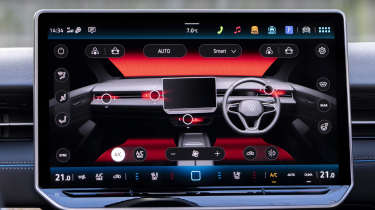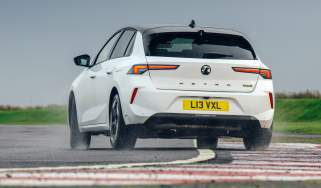Volkswagen ID.7 – interior and tech
It’s a step down from more premium German manufacturers, but improved materials and plenty of standard kit help make the ID.7 a pleasant place to be
Volkswagens of recent times have been a letdown in the interior department, with the infamous touch-based HMI and an apparent drop in build quality. While the ID.7 won’t concern the likes of BMW, Mercedes-Benz or Audi for luxury, it does provide a noticeable step up in quality over more junior models in Volkswagen’s range, with improved materials and the full suite of tech Wolfsburg has to offer.
Overall interior design is basic, but features such as the frameless rear view mirror and neatly integrated (if small) digital dash make it feel well considered. While an option, a full-length, electrochromic sunroof lifts interior ambiance, especially for rear occupants, with nifty lighting in the door cards and below the windscreen also nice to have – the latter will play light animations corresponding to various functions, such as charging and hazard light activation. Massaging, heated and ventilated front seats and an augmented reality head-up display can also be optioned, making it feel more premium than its smaller Volkswagen counterparts.
> Volkswagen ID.3 GTX Performance 2025 review – an electric Golf GTI?
The central infotainment display is large, sharp and snappy thanks to uprated hardware and a tweaked UI, but the lack of physical buttons is still highly frustrating – the only physical buttons, steering wheel aside, are the start/stop and hazard buttons, with even the air vents controlled via the touch display. New custom shortcuts help to minimise navigation time, but this is still no substitute.
The Volkswagen ID.7 feels just as roomy inside as its exterior dimensions would suggest – legroom in the rear is very impressive, and there’s plenty of storage throughout the cabin to match. The floor is also flat throughout thanks to the lack of a transmission tunnel, but it is quite high for a car of this kind – this is also a limiting factor in the boot, as while long, its depth suffers.
At a standstill and on low speed, well-paved roads, isolation from the outside world is excellent, but road noise does creep in on less perfect surfaces, with wind noise around the A-pillar noticeable. The likes of the indicator stalks and in-cabin alert sounds are well considered though, and suit the relaxed, quiet character of the ID.7. HMI niggles and occasional rattling aside, it feels like a well-rounded product with solid build quality.




